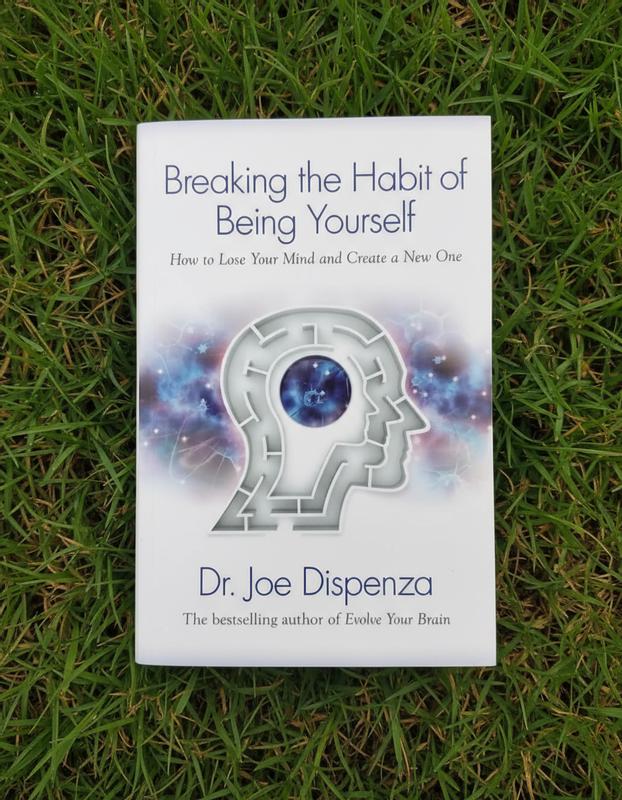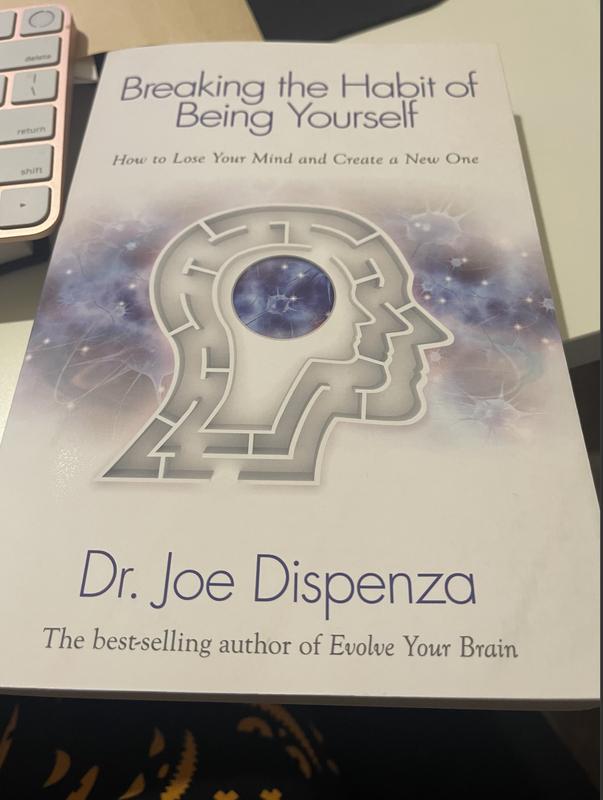Breaking The Habit of Being Yourself- How To Lose Your Mind and Create A New One by Joe Dispense
Product details
Web ID: 12269351My book notes
Below are my notes for Littler Books. I hope you find them helpful. 1. The quantum model of reality states that mind and matter are not separate. Our subjective mind has an effect on the objective, physical world. 2. Quantum physics says that an atom is " 99.99999 percent energy and .00001 percent physical substance..." 3. The observer effect in quantum physics shows that our attention directs energy. An electron exists as a wave of infinite possibilities until an observer focuses on it, causing the wave to collapse into a particle, or a physical event. a. "…a particle cannot manifest in reality…until we observe it." 4. "If you can imagine a future event in your life based on any one of your personal desires, that reality already exists as a possibility in the quantum field, waiting to be observed by you." 5. Our thoughts and feelings produce an electromagnetic signal that influences every atom in our world. 6. "The quantum field responds not to what we want; it responds to who we are being." 7. A study showed that participants could influence DNA strands when they combined a clear intention (thought) with an elevated emotion (feeling). 8. To create a new reality, we must be in a state of gratitude before the desired event occurs, signaling that it has already happened. This moves us from the Newtonian model of cause and effect (waiting for an outer event to change our inner state) to the quantum model of causing an effect (changing our inner state to produce an outer effect). 9. Our brain records everything we know and experienced in our external environment. When we react to our familiar environment, we activate existing brain circuits, causing us to think and feel in the same ways, which in turn creates the same reality. a. "We could say that the environment is actually controlling your mind." 10. Repeatedly thinking the same thoughts and performing the same actions hardwires the brain into finite patterns, creating a habit. These habits become automatic and unconscious, and form who we are. 11. To change our brain, we must mentally rehearse as if a new event has already occurred. a. Mahatma Gandhi held a vision of a future as if it was already happening. b. Studies show that people who mentally practiced piano exercises showed nearly the same brain changes as those who physically practiced. 12. "…the brain does not know the difference between the internal world of the mind and what we experience in the external environment." 13. Every thought produces a biochemical reaction in the brain that sends signals to the body, causing us to feel the way we are thinking. This creates a feedback loop where we begin to think the way we feel, and feel the way we think. 14. By age 35, about 95% of who we are is a set of memorized behaviors, emotional reactions, and subconscious programs. 15. When we try to change, the body, which has become addicted to the familiar chemical state, sends signals to the brain that talk us out of our conscious goals. 16. Epigenetics shows that the environment signals our genes. By changing our internal environment (our thoughts and emotions) we can change our gene expression. 17. A study on diabetics showed that watching a comedy show and experiencing an elevated state of mind altered 23 different gene expressions and helped to regulate blood sugar levels. 18. When our body is conditioned to a memorized emotion like grief, a trigger in the present can automatically cause the body to reexperience the chemistry of the past. 19. An emotional reaction that lasts for hours or days is a mood. When it lasts for weeks or months, it's a temperament. When it continues for years, it becomes a personality trait. 20. When we fear an upcoming event, like public speaking, our body begins to respond as if that future event is currently happening. 21. We can overcome the Big Three (environment, body, and time) to forget the future and past, stay in the present moment, so that a new reality can be created. 22. Humans can turn on the fight-or-flight stress response by thoughts alone by anticipating a future threat or reliving a past memory. 23. Living in long-term stress dysregulates our genes and can create disease. The overproduction of stress hormones also creates negative emotions like anger, fear, and anxiety. 24. Living in survival mode forces us to focus on the Big Three and causes us to become materialists, because then we tie ourselves with our physical body and external world, and we become disconnected from the quantum field. 25. Living in creation means becoming a nobody (no body, no thing, no time) in order to access the quantum field. This allows us to become self-aware (metacognition), invent a new self, and make our inner thoughts more real than our outer reality. 26. When we stop energizing the survival emotions, that energy is changed into positive emotions like joy and gratitude, and it connects us with a greater power. a. Bill, a man with recurring cancer, realized he had been living in resentment for 30 years. By inhibiting survival emotions and creating a new ideal self, he cured his cancer. 27. Learning and change progress through three areas of the brain. a. Thinking (Neocortex): We first learn philosophical knowledge, which creates new synaptic connections in our brain. b. Doing (Limbic Brain): When we apply that knowledge to create a new experience, the limbic brain produces chemicals that create a new emotion, teaching the body what the mind has learned. c. Being (Cerebellum): When we can repeat an experience at will until it becomes an unconscious skill or habit, we have activated the cerebellum (the seat of the subconscious) and have moved into a state of being. 28. A new state of being creates a new personality, and a new personality creates a new personal reality. 29. "Knowledge without experience is merely philosophy; experience without knowledge is ignorance." 30. There is usually a gap between how we appear to the world and who we really are inside. Many of us use external things (possessions, relationships, experiences, addictions) to distract us from the emptiness or pain we feel inside. 31. Closing the gap between our inner and outer selves requires unmemorizing the emotions that we have become addicted to. a. Many of our relationships are based on shared emotional bonds. When we change and break these bonds, it can be uncomfortable for those around us who were using us to reaffirm their own emotional identity. b. When we stop putting energy into maintaining a façade and release the stored emotion from the body, that energy is freed up for us to use in creating a new life. The side effect is joy. 32. “A memory without the emotional charge is called wisdom.” 33. Pamela realized she was trapped by a negative energetic bond to her ex-husband. During meditation, she consciously decided to release these destructive emotions. As a result, her reality shifted, and within days she unexpectedly received a $10,000 business promotion and $12,000 in owed child support payments. 34. Meditation is the process of becoming familiar with the self in order to go beyond the analytical mind and access the subconscious. To change, we must move from being our old self to observing our old self. 35. Jose had ten warts on his hand. He meditated and shifted from his typical thoughts to a more expanded sense of self. The next morning, all ten warts vanished. 36. How to create a new you in four weeks: a. Week one: Change your brain waves from the analytical/Beta state to the creative/Alpha state by meditating (closing your eyes and shifting your awareness from thinking to observing). b. Week two: Identify the specific problem by choosing one self-limiting emotion (e.g., anger, fear, suffering) that you want to unmemorize and its corresponding state of mind (e.g., controlling, overwhelmed, victimized). Say the emotion out loud and yield your limitations to a greater power to allow it to resolve the issue for you in an unexpected way. c. Week three: Become conscious of your automatic thoughts and actions. Write them down and redirect them when noticing them. Whenever you catch yourself thinking or acting out of the old habit, say "Change!" to weaken the old neural connections. d. Week four: Invent and embody your new self. Ask "What is the greatest ideal of myself?" Mentally rehearse this new self until the thought becomes the experience and produces an emotion. This reconditions the body to a new mind and changes your biology. You can also create the future you want by holding a clear image of it in your mind, thus commanding matter as a quantum observer. 37. You must maintain the modified state. When your inner state from meditation and your outer actions are aligned, you send out a coherent signal to the quantum field, which will respond with new feedback in your life (synchronicities, opportunities, etc.).
Customer review from barnesandnoble.com
Amazing Book and much needed
Purchased this book and it's amazing, It helped me learn so much about myself that I was actually glowing, I felt so much joy and happiness in my heart and had to tell myself that I love myself and I am doing everything I can to be a wonderful person and overall good human being. I love reading these types of book about self improvement and this helped me a lot to learn, grow and become the person I'm meant to be
Recommends this product
Customer review from barnesandnoble.com
The Mind As Something to Lose
I wonder if the previous owners who put this book out on their stoop know that losing your mind is trending; drugs, experimentation, travel, ethereal fashion, science fiction, and orchestral music accompanying a lone figure floating off into deep, dark, blue space. Do we need to break the habit of being ourselves? Or do we need to break the things that make us want to? What makes a "good" mind, Dr. Dispenza? Is it newness? Or is it a mind that doesn't want to lose itself?
Recommends this product
Customer review from barnesandnoble.com



